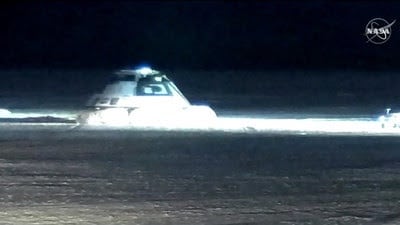Aviation
Boeing Starliner Completes First Orbital Flight Test with Successful Landing

WHITE SANDS MISSILE RANGE, N.M., Dec. 22, 2019 /PRNewswire/ — The Boeing [NYSE: BA] CST-100 Starliner’s first mission ended historically today when it became the first American orbital space capsule to land on American soil rather than in an ocean.

The spacecraft’s crew module landed at the U.S. Army’s White Sands Missile Range at 5:48 a.m. Mountain time, after spending just over two days on orbit and checking off a number of flight test objectives. The last time a spacecraft landed at the historic White Sands Space Harbor runway was in 1982, when Space Shuttle Columbia touched down, ending its STS-3 mission.
100 dead after Boeing 737 crashes in Havana
Shortly after its December 20 launch and separation from its booster rocket, Starliner experienced a mission timing anomaly that made it use too much fuel to reach the intended destination of the International Space Station. Flight controllers were able to address the issue and put Starliner into a lower, stable orbit. The vehicle demonstrated key systems and capabilities before being signaled to return to Earth.
Etihad’s Abu Dhabi facility to convert passenger planes into cargo aircraft
“The Starliner team’s quick recovery and ability to achieve many mission objectives – including safe deorbit, re-entry and landing – is a testament to the people of Boeing who have dedicated years of their lives working toward the achievement of commercial human spaceflight,” said John Mulholland, vice president and program manager of Boeing’s Commercial Crew Program. “Their professionalism and collaboration with our NASA customer in challenging conditions allowed us to make the most of this mission.”
The Starliner landing demonstrated the robustness of its landing systems, including its innovative parachutes and airbags.
Although this Starliner carried no people, it did have a passenger. An anthropometric test device, named “Rosie,” was in the commander’s seat for the entire mission. She was outfitted with about a dozen sensors that collected data to help prove Starliner is safe for future human crews.
Next, this crew module will be returned to Florida for data retrieval, analysis and refurbishment for future missions. It is the vehicle chosen to fly NASA astronauts Sunita “Suni” Williams and Josh Cassada, along with two international partner astronauts, on the first operational mission. In parallel, Boeing’s Starliner team is finalizing the vehicle that will fly Boeing astronaut Chris Ferguson and NASA astronauts Mike Fincke and Nicole Mann on the Crewed Flight Test.
For more about Starliner, visit www.boeing.com/starliner. Follow us on Twitter: @BoeingSpace.

Aviation
COMAC Unveils Plans for the C929 to Rival Airbus and Boeing

After the success of China’s first C919 aircraft, the country is setting its sights on developing a larger plane. COMAC (Commercial Aircraft Corporation of China) has officially confirmed plans to build a widebody aircraft, marking a significant step in its aircraft lineup.
Traditionally, Airbus and Boeing dominate the widebody aircraft market, with decades of expertise in developing planes and engines capable of carrying heavy payloads. China, which currently relies on imported engines, is now aiming to challenge these giants with its own widebody jet, the C929, designed to compete with the Airbus A350 and Boeing 777.
American Airlines Is Looking for Flight Attendants: Apply Now
The C929 will be China’s first independently developed long-range widebody aircraft. It adheres to international airworthiness standards and boasts independent intellectual property rights. The baseline version is designed to seat 280 passengers and offers a range of 12,000 kilometers, catering to global demand for both regional and international air travel.
Russia, which also needs reliable narrowbody and widebody aircraft, could become a key customer for the C929. Additionally, China plans to target the broader Asian market as it continues to expand its aviation capabilities.
Close Call at Heathrow: BA Flight Narrowly Escapes Drone Collision
China’s aviation progress includes the ARJ21 (now called C909), a regional jet with 100 seats for shorter routes, and the C919, a narrowbody jet with 180 seats designed to rival the Boeing 737 MAX and Airbus A320. Both models have found increasing demand in the domestic market.
At China’s largest air show in Zhuhai, COMAC announced that Air China will be the launch customer for the C929 widebody jet, though details about order size and delivery timelines were not disclosed.
Other major deals announced by COMAC include:
- Hainan Airlines: Firm orders for 60 C919 and 40 C909 regional jets.
- Colorful Guizhou Airlines: 30 C909 jets, with 20 firm orders and 10 provisional agreements.
The C929, renamed from the CR929 after Russia withdrew from the joint development project in 2023, is expected to carry 280–400 passengers with a range of 12,000 kilometers, competing directly with Boeing’s 787 Dreamliner.
According to COMAC’s deputy general manager, Tong Yu, the first fuselage section of the C929 is expected by September 2027, with prototype test flights anticipated soon after.
-

 Aviation2 months ago
Aviation2 months agoMicrosoft Flight Simulator Raises $3 Million to Bring Back the An-225 Mriya
-

 Airlines2 months ago
Airlines2 months agoQantas Engineers Stage Walkout Over Cost of Living Concerns
-

 Airlines2 months ago
Airlines2 months agoQatar Citizens Can Travel to the United States Without a Visa
-

 Aviation2 months ago
Aviation2 months agoQatar Airways bans these new Electronic Devices on plane
-

 Airlines2 months ago
Airlines2 months agoJapan Airlines Rolls Out Free Domestic Flights to International Passengers
-

 Defence2 months ago
Defence2 months agoWhich Country Has the Largest Fleet of Fighter Aircraft?
-

 Airport2 months ago
Airport2 months agoWestern Sydney Airport Welcomes Its First Plane After 6 Years of construction
-

 Aviation2 months ago
Aviation2 months agoDid you know ? Once Boeing 747 carried 1088 passenger in 1991








